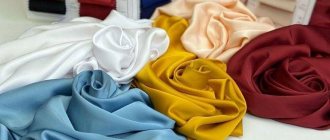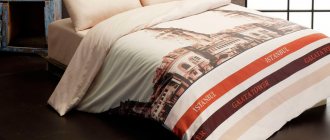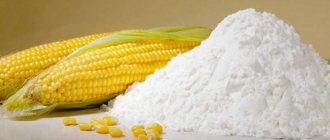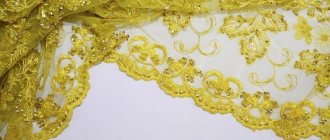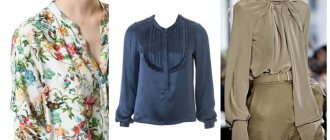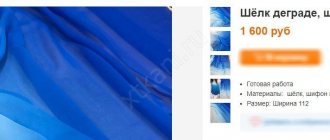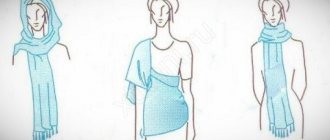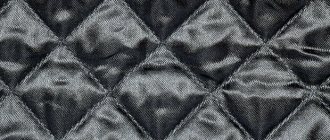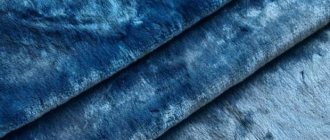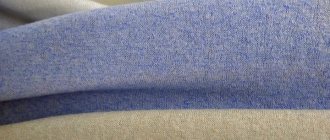Silk is a natural fabric that has long become popular in many countries.
It consists of thin natural fibers that are extracted from silkworm cocoons. It is used to sew beautiful wardrobe items, interior decorations, bed linen, and make souvenirs.
The fabric is attractive with its shine and shimmer. Due to its remarkable properties, silk is in demand in clothing production.
There are several varieties. It depends on the way matter is created:
- crepe - chiffon, georgette;
- semi crepe types;
- dense, jacquard fabrics;
- smooth fabrics.
How is silk made?
The production of natural silk is a very labor-intensive and long process.
Its main characters are silkworm caterpillars, who work “by the sweat of their brow” to produce fiber. A thread is subsequently obtained from it. Of the 3500 m of fiber contained in the cocoon, only 1000-1500 m of silk thread can be obtained. An interesting fact: in Asian countries, after removing the silk from the silkworm cocoon, the pupa is not thrown away, but used for food, having previously been candied or fried.
The original silk thread is yellow in color, so it is bleached by soaking it in a hot alkaline solution for several hours. When it turns white, it is painted with natural or chemical dyes in all the colors of the rainbow.
Thanks to the work of breeders, today we have quite a few breeds of silkworm. They are distinguished by productivity, life expectancy, thread quality and other characteristics important for the production of natural silk.
Modern production
Now silk is a popular expensive fabric. The price is justified by the scrupulousness and labor involved in making the thread. Special factories equipped with high-tech equipment have been opened in many parts of the world.
The production method differs from the original one, but valuable silk is also obtained from the silkworm.
- Employees of the enterprise monitor the temperature regime. Deviation from the norm can result in dire consequences. The larvae may die, and the producer will suffer huge losses.
- On average, it takes one caterpillar 4 days to envelop itself in a cocoon.
- Afterwards, under the influence of special steam, the larva is killed, and the created cocoon is unwound on special equipment.
- The finished threads lack shine and have a yellowish tint.
- The product is sent to weaving factories where it is dyed to the required color.
Properties and types of silk
Silk thread is elastic, elastic, shiny, and lends itself well to dyeing. It produces a delicate and soft, yet very durable fabric that captivates hearts with its luxurious shine, smoothness and pleasant tactile sensations. These qualities allow you to turn a blind eye to the capriciousness and demands of silk.
Depending on the breed of silkworm, the country, the conditions of detention and the diet of the caterpillars, different types of silk fabric are distinguished. There are quite a lot of them. They differ in properties, type of thread weave, appearance and other characteristics.
The most popular types of silk:
- Satin
is dense, smooth, with a shiny front side that looks like gloss. Characterized by a satin type of thread weave. - Toile
is a very dense fabric with a delicate shine. Keeps its shape perfectly. - Chiffon
is a transparent fabric, thin and soft, with a rough texture and a matte surface. Drapes well. Lightweight and beautifully flowing material. - Organza
is a glossy or matte translucent lightweight fabric. - Silk-satin
is a dense fabric of satin weave with a smooth front side, characterized by a noble shine. - Gas
is a transparent lightweight fabric without shine.
For production, various types of weaving are used, depending on which they obtain:
- illusion gas - so thin and light that it resembles a colored spider web;
- gas-rice - got its name from the type of weaving (rice), transparent and slightly rough;
- gas crystal - characterized by a shiny iridescent surface due to the use of multi-colored threads;
- gaz marabou is a golden fabric made of tightly twisted threads.
- Crepe
(crepe de Chine, crepe georgette and other varieties) is a fabric with a rough texture, which is achieved by twisting the threads left and right in a certain sequence. The crepe is wear-resistant, does not wrinkle, and lends itself perfectly to draping. - Taffeta
is a dense, stiff fabric made from tightly twisted threads. Synthetic fibers are often used to make it. - Chesucha
is a dense and durable material made from threads of different thicknesses. Soft, slightly shiny. - Brocade
is a heavy fabric with a pattern embroidered with metal thread. Today, the pattern is also made from silk, cotton and linen threads. - Dupont
is a dense, medium-stiff fabric that is made almost entirely from natural silk. This is an exclusive material with a pleasant shine. - Twill
- characterized by a diagonal weave of threads. It can be plain painted or printed. - Silk cambric
- this material consists of approximately 3% silk threads, which makes things made of it shine. Flows effectively, forming beautiful folds.
Story
Making silk in Ancient China
It all started with the fact that three millennia before the birth of Christ, a nondescript butterfly with a light color - the silkworm - was domesticated in China. The name of the insect is due to the fact that caterpillars feed on mulberry or mulberry leaves.
According to legend, the Yellow Emperor's wife, 14-year-old Empress Xi Ling Shi, saw a cocoon fall into her cup of tea. The girl carefully took it out, but under the influence of heat and moisture the fibers unraveled. Amazed by the elegance and fineness of the thread, the empress wove the first silk fabric.
At the insistence of her husband, Xi Ling Shi spent time observing the life of mulberry caterpillars. Then the young empress taught the art of making fabric to her entourage. In Chinese mythology, Xi Ling Shi is considered the patroness and goddess of silk. Only high-ranking nobles and representatives of the imperial family wore silk clothes; ordinary peasants did not have the right to use the precious material.
Masters of calligraphy practiced on silk canvases, and artists created sophisticated paintings. Bows and musical instruments were made using silk.
Life cycle of the silkworm
For a long time, no other country in the world knew the secret of making oriental fabric. In 522, the first cocoons appeared in Byzantium. At the same time, independent fabric production began in the Arab world. However, no one has been able to surpass the quality of authentic Chinese silk.
With the advent of the loom, production became more efficient. They invented a jacquard loom for weaving large-patterned fabrics and fine silk embroidery. Modern synthetic fabrics have replaced silk and replaced it with more affordable textiles. As in ancient times, natural silk is now considered a luxury item.
Application of silk
Silk is used in many industries, but the main share is in the following:
Light industry
Silk fabric is most widely used, of course, in the textile industry: beautiful clothes, luxurious bed linen, curtains and tablecloths, bright accessories - this is only a small part of the consumer goods that can be found on sale. Things made from natural silk are not cheap, but that doesn’t make them any less loved and popular.
Medicine and pharmaceuticals
Silk is a natural sterile thread based on proteins. Soft, smooth and flexible silk thread is ideal for suturing wounds, which is why it has been used in surgery for many years. Today, dressing materials, protective masks, orthopedic implants and other biologically compatible devices are made from silk.
Cosmetology
We've all seen advertisements for cosmetics containing silk proteins. This is not just a marketing ploy. Cosmetics manufacturers actually add silk thread components to their products: proteins, peptides and amino acids, which have a positive effect on skin and hair. These cosmetics are quite expensive.
Characteristics
Silk is a natural material that has a glossy shine and is highly durable. The average fiber thickness is 13-14 microns.
What does a silkworm do?
The caterpillar, only 7 centimeters long, begins the construction of the future cocoon from the frame. Then she makes uniform movements, laying the thread in a shape reminiscent of the number “8”. After completing the labor-intensive work, the caterpillar is sent to the finished “house”.
Positive properties of natural silk
Silk, like any other fabric, has its advantages and disadvantages. Positive properties include:
- Aesthetically attractive: delicate, flowing, shining, noble;
- Practical - with proper care, it lasts a long time, maintaining its original appearance and unique attractiveness;
- In hot weather, silk clothing pleasantly cools, in cool weather it warms, allowing you to feel comfortable;
- Has antibacterial properties: prevents the growth of bacteria. Silk bedding is completely unattractive to lice, ticks and other unwanted neighbors;
- In clothes made of natural silk, the skin breathes freely;
- Absorbs moisture well, remaining dry to the touch. Dries quickly.
Care
Connoisseurs of materials obtained through natural means should remember that the material is capricious and requires its owners to be scrupulous in wearing it. In order not to spoil your favorite clothes, you need to follow the following rules of care:
- natural material, like semi-silk fabrics, are not friendly with alkali, so washing with soap or powder is not recommended. It is better to use shampoo or specialized products for such purposes;
- Washing and rinsing clothes occurs at low temperatures. It is not recommended to squeeze things out in a machine;
- drying of products occurs only in unfolded form;
- Iron items from the wrong side, at temperatures up to 70 degrees.
Disadvantages of silk
Natural silk fabric, for all its positive qualities, also has some disadvantages:
- Requires delicate care;
- Loses its aesthetic appearance when drops of liquid get on the surface;
- Does not tolerate prolonged exposure to ultraviolet radiation - loses strength;
- Some types of silk wrinkle a lot.
Life hack: to ensure that dyed silk retains its bright, rich color longer, rinse it in water with the addition of vinegar (for 10 liters of water, 5 tablespoons of 9% vinegar).
Natural silk fabric is quite expensive, but it is really worth it. It is not for nothing that it has always been considered imperial - its merits are difficult to overestimate, and its shortcomings simply fade in comparison with them.
Do not deny yourself the pleasure of purchasing silk fabric for sewing luxurious products that will delight you for many years. The range of fabrics can be found here.
